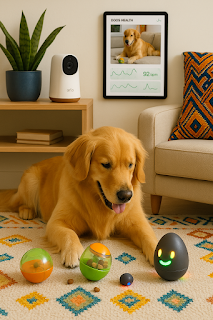How Telemedicine Data Improves Pet Care
Welcome to Data & Tools Tuesday at The Vet Vortex! Today, we’re venturing into a space where technology meets veterinary care in a big way: Telemedicine.
You’ve probably heard of telemedicine for humans, but did you know that your furry friends can also benefit from virtual veterinary visits? In today’s post, we’ll be breaking down how telemedicine, fueled by smart data, is changing the way we care for our pets and how it’s making life a little easier for both owners and veterinarians.
The Rise of Telemedicine in Vet Care
But what makes telemedicine so effective for pets? Data. That’s right, telemedicine for pets is not just about chatting with a vet; it’s about using data to improve care, and that’s where it gets really exciting!
Data: The Unsung Hero Behind Telemedicine
When you connect with a vet online, data is the secret ingredient that ensures the consultation is as effective as possible. From tracking your pet’s vital signs to providing real-time health updates, the role of data in telemedicine is indispensable. Here’s how:
- Smart Health Devices: Think of wearables like fitness trackers, but for your pets. These devices monitor things like heart rate, sleep patterns, activity levels, and even temperature. This data can be shared instantly with your vet during a virtual consultation, helping them make more accurate diagnoses. Imagine telling your vet, “My cat hasn’t been eating as much lately,” and they ask, “How’s her activity level been?” Based on the data from her collar, they can immediately assess if it’s something to worry about.
- Health Records at Your Fingertips: With telemedicine, your pet’s health history is always available online. Most telemedicine platforms allow pet owners to upload medical records, lab results, and vaccination schedules. This makes it easier for the vet to track your pet’s health journey, ensuring that no detail gets missed. It’s like having your pet’s medical file in your pocket, ready to share with your vet whenever needed.
- Tracking Symptoms Over Time: Telemedicine platforms often allow owners to input daily updates about their pet’s symptoms. From changes in appetite to unusual behavior, this data helps your vet see patterns. A consistent temperature rise or ongoing limping? This data could lead to early detection of an issue, giving the vet a chance to recommend treatment before things escalate.
The Benefits of Telemedicine Data
Okay, so we’ve established that data plays a key role in telemedicine. But how does that translate into real-world benefits for your pet and you? Let’s dive into the good stuff:
- Convenience for You: Telemedicine means fewer trips to the clinic, especially for follow-up visits. If your pet has just had surgery or a routine check-up, a virtual visit can save you time and stress. And if you have multiple pets? Even better! You can schedule consultations from the comfort of your home, and the vet can review all their data and health records in one go.
- Early Detection & Proactive Care: With all that data flowing between you, your pet, and the vet, telemedicine can help spot potential health issues before they become serious. Catching an issue early means less invasive treatments, lower costs, and a quicker recovery time for your pet.
- Improved Continuity of Care: For pets with chronic conditions, telemedicine ensures they’re closely monitored. Data sharing helps the vet adjust treatments as needed, ensuring your pet’s condition is managed effectively. No more wondering if the medication is still working - now, it’s all about real-time insights.
- Reduced Stress for Your Pet: Let’s face it, not all pets love going to the vet. Some animals are anxious in new environments, which can make it harder for them (and you!) to get the care they need. With telemedicine, you can avoid that stress and get your pet the help they need from the comfort of your home.
Data Security: Keeping Your Pet’s Info Safe
I know what you’re thinking: “What about privacy? How do I know my pet’s data is safe?” Rest assured, most telemedicine platforms take data security very seriously. They use encryption, secure servers, and privacy protocols to keep everything safe and sound. Your pet’s health data will be just as protected as your own.
A Peek Into the Future
So, where does this leave us? Beyond the stethoscope, it’s clear that telemedicine is transforming pet care. By harnessing the power of data, we’re not just diagnosing illness; we’re preventing it. We’re building a future where technology and veterinary care work hand-in-paw to ensure your pet is happy, healthy, and thriving.
Over to You!
Are you ready to give telemedicine a try for your pet? Do you think it could make a difference in your routine vet visits? Share your thoughts in the comments below, or ask any burning questions you might have! And remember, this is just one way data and tools are changing the game in pet care. Join us next Tuesday for more exciting insights on how tech is reshaping the world of animals.
Thanks for reading, and stay tech-savvy, pet parents!
Check out previous post - Do Cats Always Land on Their Feet?


